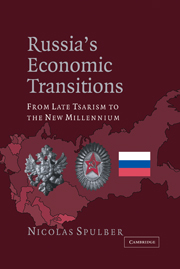Book contents
- Frontmatter
- Contents
- Figures and Tables
- Preface
- PART I THE TSARIST ECONOMIC TRANSITION
- PART II THE SOVIET ECONOMIC TRANSITION
- PART III THE POST-SOVIET ECONOMIC TRANSITION
- 19 The Socioeconomic Framework
- 20 The Transition Issues
- 21 The Economic Policies
- 22 The Problems of Agriculture
- 23 The Industrial Changes
- 24 Domestic and Foreign Trade
- 25 Money and Banking
- 26 State Finance
- 27 Overall View
- Index
19 - The Socioeconomic Framework
Published online by Cambridge University Press: 03 December 2009
- Frontmatter
- Contents
- Figures and Tables
- Preface
- PART I THE TSARIST ECONOMIC TRANSITION
- PART II THE SOVIET ECONOMIC TRANSITION
- PART III THE POST-SOVIET ECONOMIC TRANSITION
- 19 The Socioeconomic Framework
- 20 The Transition Issues
- 21 The Economic Policies
- 22 The Problems of Agriculture
- 23 The Industrial Changes
- 24 Domestic and Foreign Trade
- 25 Money and Banking
- 26 State Finance
- 27 Overall View
- Index
Summary
Territory and Population
The disintegration of the Soviet Union in December 1991, and its replacement by a Russian Federation and by a “commonwealth of independent states,” had been preceded by a dramatic series of conflicts and maneuvers between two Communist leaders, Mikhail Gorbachev and Boris Yeltsin. Already in 1989, Yeltsin had positioned himself as the main antagonist of Gorbachev and as an alternative leader. At the time, Gorbachev himself was trying to strengthen his capacity to circumvent the Soviet bureaucracy's opposition to reform, by creating an executive presidency of the USSR and by being appointed to this position. The measures were finally enacted in 1991, but Gorbachev's powers remained in fact limited. His presidential decrees were disregarded as the Union was increasingly torn apart by innumerable difficulties and conflicts. In the meantime, the powers of Yeltsin grew appreciably. He was elected as leader of the Supreme Soviet in May 1990, and then established through a Declaration of State Sovereignty ratified by the Congress of the Russian Republic the primacy of Russian law over Soviet law on its territory and, at the same time, the idea of economic sovereignty for all the other Union republics. By February 1991 he insistently called for Gorbachev to resign as president of the Soviet Union, and soon afterward, on June 12, 1991, Yeltsin succeeded in being elected president of Russia.
- Type
- Chapter
- Information
- Russia's Economic TransitionsFrom Late Tsarism to the New Millennium, pp. 287 - 302Publisher: Cambridge University PressPrint publication year: 2003



